News
Dive Notes from a Small Island: Part 6 – Scottish Lochs and Final Thoughts…
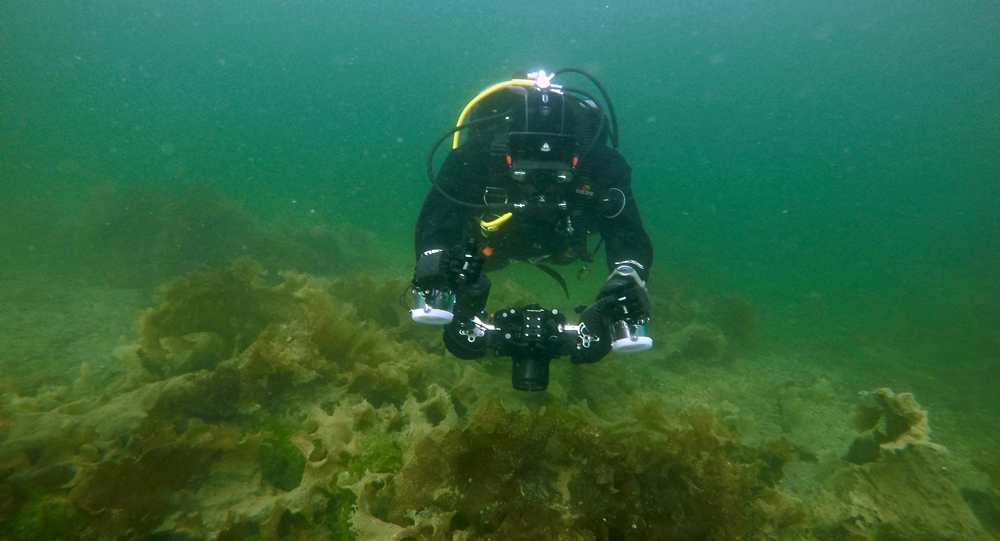
After our brilliant week in the Orkneys, it was time to make our way back to the North West as our trip was coming to an end. Since we were driving past Oban and several Scottish lochs, it seemed rude not to hop in for one or two last shore dives on the way. Having heard good things about Oban we headed down the west coast and found Puffin Dive Center, just out of the town along Gallanach Rd. PDC offers boat dives, has a very nice set up and friendly staff; as we were on a bit of a tight schedule we just had time for a quick shore dive from their dock to the house reef. From Oban we drove south via Loch Long, where I had previously done a dawn dive as part of the ‘Three Deeps Challenge’, a charity fundraiser a few years ago. I remembered Loch Long having easy entry, good visibility and lots of life, so was keen to show Mike this dive as well, before packing away our dive kit for a while.
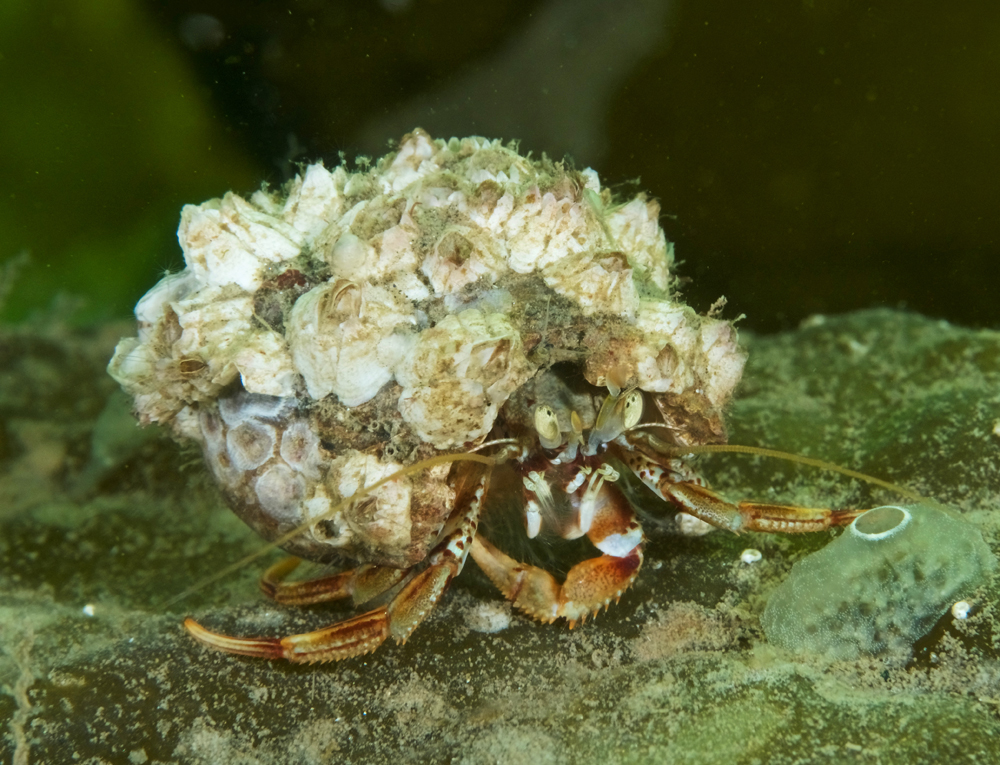
Dive 22: Puffin House Reef, Oban
Site description:
This reef has a max depth of 18m, though most of the dive is shallower 8-12m. With a silt bottom and kelp in the shallows, the visibility is about 5m on average. The reef is easy to navigate by swimming west out from the PDC dock to around 8m and then turning south until you hit the reef. Explore the reef then return east to get back to shore. The reef is 1km long and so there is plenty to explore and common sightings include octopus, crabs, nudibranchs and lobster. It can be dived at any state of tide.
The Dive:
The silty bottom is home to lots crabs, shrimp and scallops. We had an explore down to about 12m and found some nudibranchs on some seaweed. On the reef we spotted a couple of octopus hiding in their holes and eyeing us suspiciously. The visibility was about 5m and the temperature a nice warm 13°C allowing us an easy 62min dive.
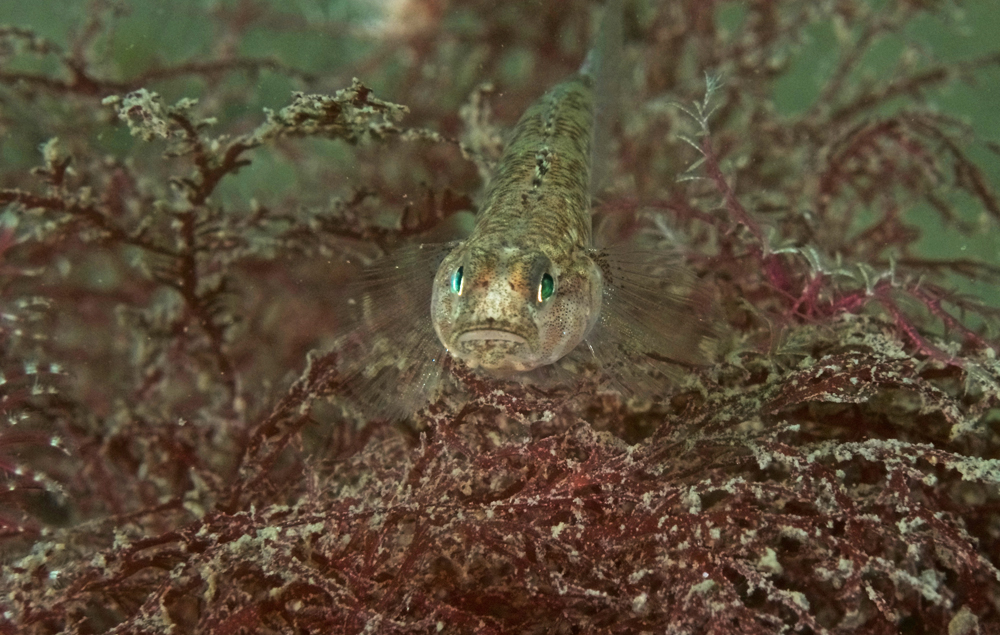
Mike’s Thoughts:
This was more like a muck dive than previous sites we’d visited in the UK, with a large expanse of silty ground to explore before we made our way to the sloping rocks of the ‘reef’ in the middle of the Kerrera sound. The silty bottom was crawling with life, including whelks, squat lobsters and dragonets and gobies. What I thought was a piece of seaweed tumbling along the bottom turned out to be a very interesting long-legged spider crab bedecked in red algae. The site was easy to navigate and was another great place for a quick shore dive.
Dive 23: The A Frames (Finnart oil terminal), Loch Long
Site description:
The site is easily accessible from the car park next to the Finnart oil terminal on the A814 and is the site of an old pier that was dynamited. A mix of rocky reef with pier wreckage, it is suitable for all divers and accessible at all states of tide, though strong currents can be present below 20m. Lots of life can be seen here, and it is best with few divers as silt can be stirred up and reduce visibility. Take a heading to the white lighthouse on the far shore of Loch Long for navigation and beware boat traffic coming to the oil terminal.
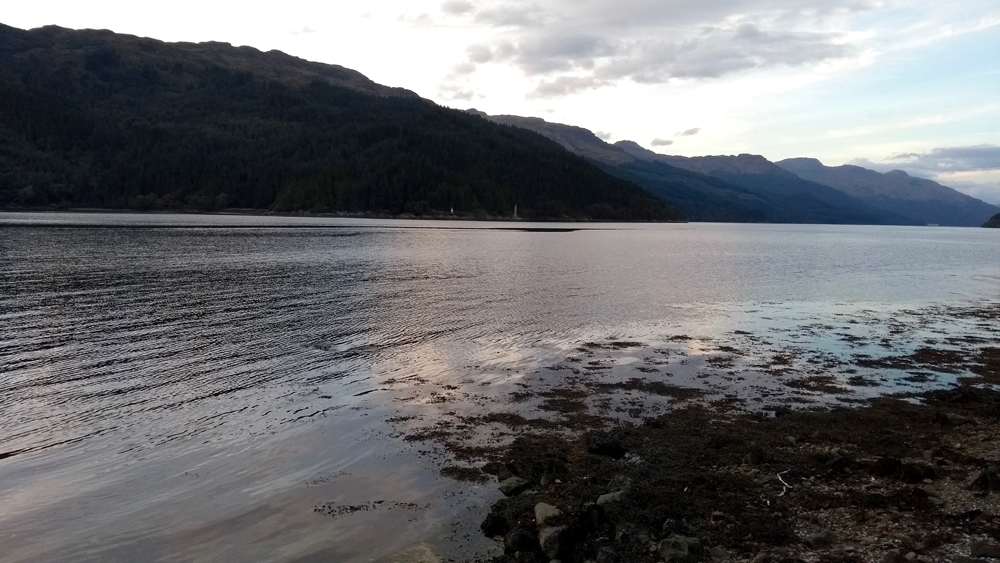
The Dive:
We arrived early as we had heard the site could get very busy and were not surprised when lots of other cars turned up. It turned out there was a PADI instructor exam taking place, so we decided to get in quickly, so we might be out of the way by the time the instructor candidates had completed their briefings. The top 5m of water was a brown tannin layer, with less than half a meter visibility. We descended through this having done a short surface swim and at 6m, went through a thermocline and into very clear water. With the heavy cloud cover and tannin layer above we had very little light and proceeded in night dive conditions. Despite the good visibility deeper down there was not a lot of life on this dive, in stark contrast to the last time I dived here. We did see sea urchins, crabs and above us the silhouette of a huge lion’s mane jellyfish. As there was not a great amount to see and quite dark we kept the dive short, just 25mins as we also wanted to let the examination group get on with their dives. Speaking to some locals as we de-kitted, I found out that the site is often hit and miss, some days being packed with life and other days not, sometimes without any tannin layer at all and this reassured me that I had not misremembered my original dive.
Mike’s Thoughts:
I had an interesting time in my first Scottish loch. After seeing the atrocious visibility on top upon initial descent, I thought we might have a very short dive indeed. Fortunately things improved a bit deeper and the experience of dropping through the dark tannic water into the crystal clear below was quite cool. Despite the daylight hour it really became a night dive for us, although the sea life didn’t live up to expectations. Aside from a few widely-spaced dragonets, urchins, and the usual crabs there wasn’t much to see as we swam around. We may not have ventured far enough from shore, or we just didn’t have much luck that day. At least the surrounding area above water was beautiful!

CJ’s trip summary:
I feel incredibly lucky to have been able to take the time to show Mike round my native waters and get some fantastic diving done; it’s not always the case that you can take a couple of months break from work and just go and have fun, especially with a great and like-minded dive buddy.
I’ve always been passionate about UK diving and believed that we had some world class dive sites to enjoy, if you are willing to take the plunge into temperate waters. During this trip I was really hoping that Mike would get to experience this for himself and wouldlove the diving here as much as I do. Sometimes the visibility isn’t good, or the weather blows out the dive, but this is part and parcel of UK diving. However in the last few weeks I have also had the opportunity to see lots of new places and been able to dive sites I have been wanting to visit and it has been utterly brilliant!
For anyone wanting to visit any of the places we have been, we have included some recommendations of dive centers and skippers that were great and made our trip. Finally, if you want to go and dive somewhere, our recommendation would be to absolutely make time to do it. Sometimes the conditions may not be perfect, but as long as its safe, it’s always great being underwater!
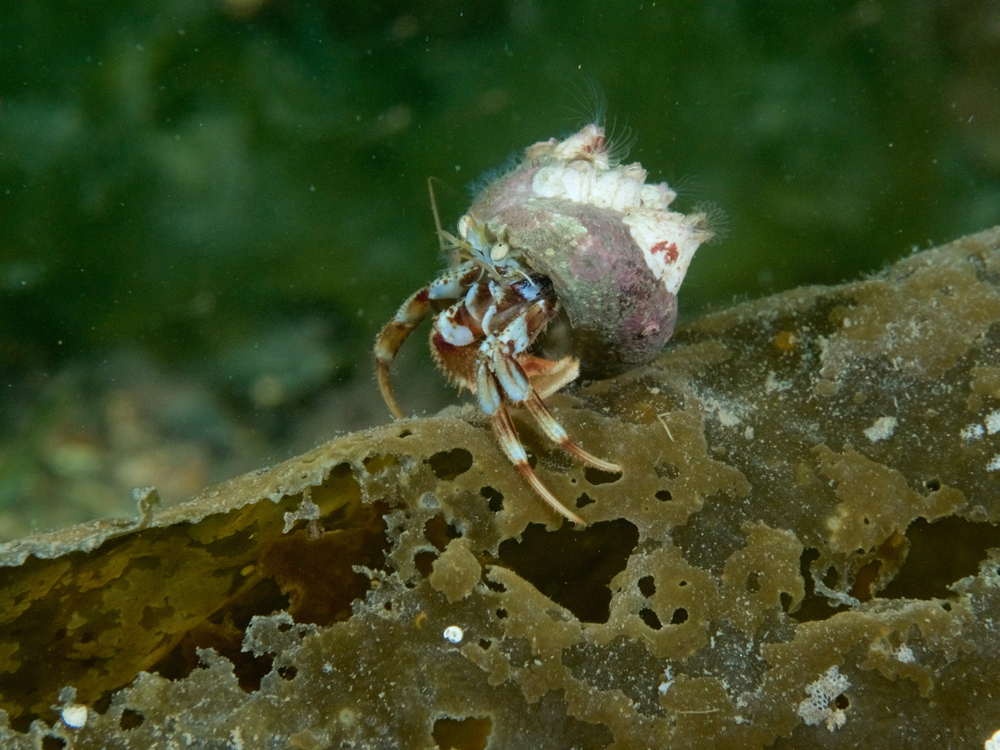
Mike’s Trip Thoughts:
Looking back on two months of travel and diving around the UK and Ireland, a few thoughts come to mind. First of all, the dive conditions were fairly challenging more often than not. When planning an ocean dive here, one has to expect colder water, generally low visibility, and factor in tide and current. This meant being a more attentive and prepared diver; losing sight of your buddy or dive group is always a possibility and you must be aware of your surroundings. It also made capturing quality underwater photos quite a challenge for me at times. The good thing is that with the proper equipment (a drysuit, good lighting, and DSMB and reel) and the right mindset there is a lot to love. I enjoyed many firsts on our trip and got to observe and photograph many new species. Even common species here like sea mats, long-clawed squat lobsters, tompot blennies and dogfish were a delight to see, and riding the diver lifts on the boats was novel at first! Diving in the UK really has a lot to offer … unique marine flora and fauna, interesting underwater formations, miles of stunning coastline, and hundreds of diveable shipwrecks. Having a post-dive pint at the pub was the icing on the cake. I can heartily recommend the UK as a diving destination; it’s well worth a visit!
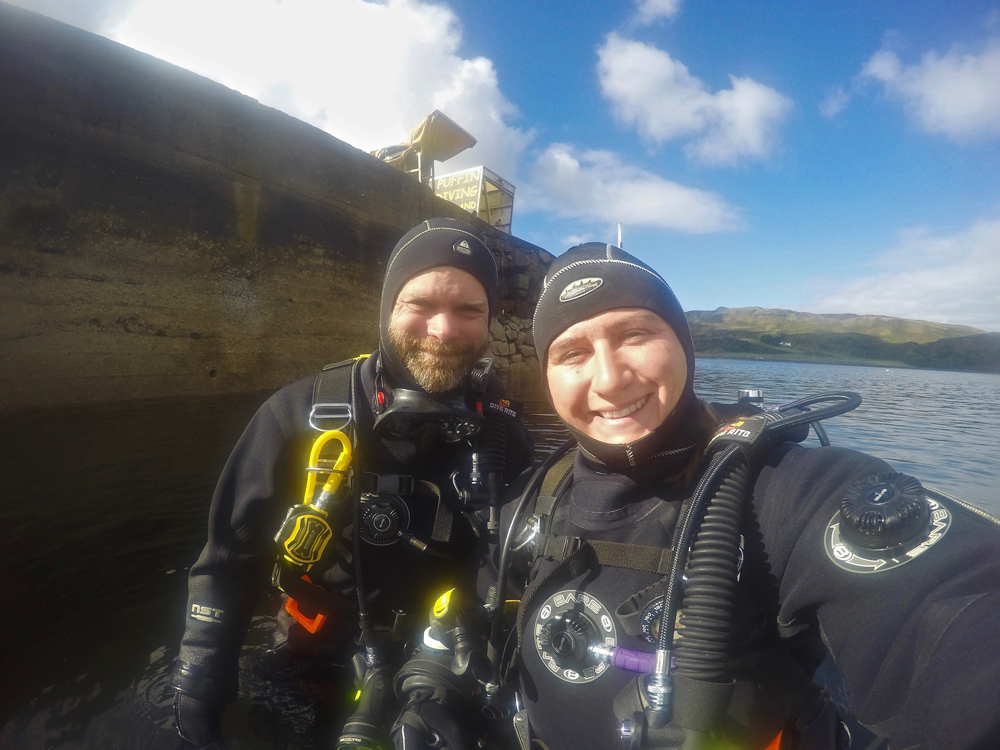
Our recommendations:
Cornwall:
- Seaways Diving, Penryn. (Great advice, cheap air fills, shop, boat trips)
Porthkerris Divers, Porthkerris. (Campsite, boat trips to Manacles, Drawna rocks shore dive, shop & courses). - Roskilly’s Ice Cream. (Food, amazing ice cream).
Dorset:
- Divers Down, Swanage. (Pier dive info, shop, air fills, boat trips & courses).
Ireland:
- Scubadive West, Co. Galway. (Shore dive, boat dives at weekends, shop, air fills & courses).
Northern Ireland:
- Aquaholics, Portstewart. (Boat dives, local advice, shop, air fills & courses).
Farne Islands:
- Sovereign Diving, Seahouses. (Boat dives).
- Olde Ship Inn, Seahouses. (Great beer selection, food & accommodation).
Scotland:
- Marine Quest, Eyemouth. (Boat dives, accommodation, air fills).
- Scapa Flow Charters, Stromness. (Boat dives, liveaboards & air/nitrox fills).
- Scapa Scuba, Stromness. (Drysuit repair, air fills, shop, guided dives & courses).
- Puffin Dive Center, Oban. (Boat dives, shore dive, air fills, shop & courses).
News
Book Review: Fire on Monroe Bravo by Fred Lockwood

Fire on Monroe Bravo is the latest book in the Jack Collier series by Fred Lockwood. Our story begins with our lead characters, Jack and Sandro, owners of Marine Salvage & Investigation Company, arriving on the Monroe Bravo Oil & Gas Platform in the North Sea. Having secured a contract for their vessel the MV Stavanger to act as support ship to the platform for TransGlobal Oil, our protagonists are on a celebratory visit.
However almost as soon as they arrive a series of explosions rock the platform, causing huge damage, loss of life and the very real danger of a massive human, ecological and financial disaster.

As the danger mounts for both our heroes and the surviving workers, Jack and Sandro will have to escape the inferno, all while trying to save the platform and the men still trapped unable to help themselves.
The disaster sets the scene for the unfolding story lines following the fate of the platform and our main characters, the police investigation into a suspected terrorist act and the actions of TransGlobal Oil as they attempt to navigate the pubic outcry and financial repercussions.
In his eighth book, Fire on Monroe Bravo, Fred Lockwood delivers an explosive thriller, with plenty of above and in-water drama, and our heroes fighting for survival, what more can you ask for?
We thoroughly recommend this read and look forward to the next in the series. For more information about his book series, you can check out the reviews of his previous books here on Scubaverse.
- Title: Fire On Monroe Bravo
- Author: Fred Lockwood
- ISBN: 979-8325324536
Available in a paperback version and for Kindle from Amazon and book stores.
Blogs
Alonissos: The complete diving destination (Part 1)

In June we were incredibly fortunate to be invited to dive in Alonissos, a small Greek Island in the Sporades island chain located in the North Aegean Sea. While I have long been a big fan of the Greek Islands as a great holiday destination, I had not had the opportunity to do any diving on previous visits and Mike and I were extremely excited to see what Alonissos had to offer both above and below the surface!

The Sporades are easily accessible via the airport in Skiathos (the first island in the chain), which is served by Jet2 flights from all major UK airports from May through October. Numerous ferries and charter boats make island hopping from Skiathos Town a breeze. After an hour boat ride, the picturesque port of Patitiri was a wonderful introduction to Alonissos, where we were met by our gracious hosts Kostas of Albedo Travel and Dias of Alonissos Triton Dive Center. Mike and I were delighted to be staying at the Paradise Hotel, aptly named for its stunning views over the sea and great location for walking to the waterfront.

Alonissos is beautifully situated in the National Marine Park of Alonissos and the Northern Sporades, the largest marine protected area in Europe. The surrounding seas offer fabulous marine life, including incredibly rare species such as the Mediterranean monk seal. They boast deep walls covered in gorgonians and sponges, stunning topography with caverns, swimthroughs and pinnacles, and the first accessible ancient shipwreck from 500BC!

In locations where historical sites have been reported, the waters are largely restricted, but with collaboration between government, underwater archeologists and dive centres, incredible underwater museums are being created for a truly unique diving experience. Alonissos is home to the first of these, the Ancient Shipwreck of Peristera Accessible Underwater Archeological Site. The chance to dive into history (along with reports of healthy reef life and amazing underwater topography) meant Mike and I were keen to get in the water.

Our introduction to the diving around Alonissos was at the Agios Georgios Pinnacles, in the channel between Alonissos and Skopelos. This fantastic site was named “The Chimney,’ and proved to have a huge amount to see. We got to a decent depth here (over 25m), and marvelled at a colourful reef wall with a wonderful swim through whose rocky walls were absolutely covered with life. As well as brilliant topography there was no shortage of macro life here. We saw numerous nudibranchs, five different species in total. The second dive at Mourtias reef nearby was a shallower dive along a nice wall with lots of crevices. Several moray eels and grouper called this site home. We enjoyed looking in the crevices for lobster and smaller benthic life, such as cup corals and tunicates.

Our itinerary allowed us two dives a day with afternoons left to explore the island with our hire car and evenings to enjoy the famous Greek hospitality. This proved to be a lovely mix of in-water and land based diversions.

The next days diving to the Gorgonian Gardens and Triton’s Cave was to be even better! These two stunning sites are nothing short of fabulous. The Gorgonian Gardens was a deep wall near to the Agios Georgios islands. The ever-present currents in this deep channel meant that the sea life was amazing … the namesake Gorgonian sea fans dotted the wall at a depth of 30 to 50 meters, getting ever larger the deeper we went. Above 30m was by no means less beautiful, with sponges, corals, scorpionfish, moray eels and some rare and colourful nudibranchs.

The second shallower dive of the day was to Triton’s Cave or the Cavern of Skopelos, on the east side of that island. The spectacular rock formations had wild striations both above and below the water making a truly epic topography. The cavern entrance was at 14m, and big enough for a buddy pair, winding up to 6m and passing two beautiful windows out into the blue. Emerging from the cavern, the light at the shallower depths and the incredible rock formations made for a fantastic gentle swimming safety stop and we all surfaced by the boat with massive grins.

Check out our next blog :Alonissos: The complete diving destination (Part 2)” to hear about our amazing dive on the 2500 year old Peristera Wreck!
Thanks to:
Alonissos Triton Dive Center https://bestdivingingreece.com/
Albedo Travel https://alonissosholidays.com/activities/
Paradise Hotel https://paradise-hotel.gr/
Alonissos Municipality https://alonissos.gr/en/
-

 Blogs2 months ago
Blogs2 months agoDiving With… Nico, Ocean Earth Travels, Indonesia
-

 News1 month ago
News1 month agoMurex Bangka Announce New Oceanfront Cottages & Beachfront Dining
-

 Blogs2 months ago
Blogs2 months agoA new idea in freediving from RAID
-

 Marine Life & Conservation1 month ago
Marine Life & Conservation1 month agoIceland issue millionaire whale hunter a licence to murder 128 vulnerable fin whales
-

 Marine Life & Conservation2 months ago
Marine Life & Conservation2 months agoThe Shark Trust Great Shark Snapshot is back
-

 News3 months ago
News3 months agoCharting New Waters; NovoScuba Goes Global with the Launch of their Revolutionary Dive Training Agency!
-

 Gear News1 month ago
Gear News1 month agoNew Suunto Ocean – a dive computer and GPS sports watch in one for adventures below and above the surface
-

 Marine Life & Conservation Blogs2 months ago
Marine Life & Conservation Blogs2 months agoBook Review: Plankton















